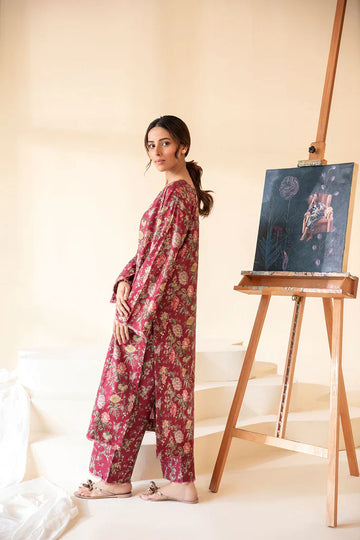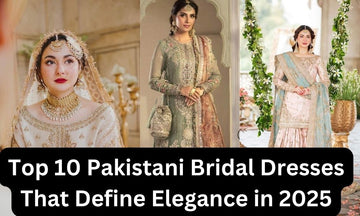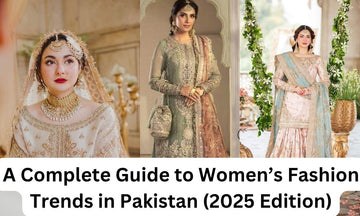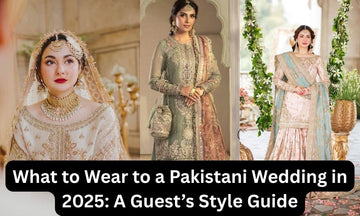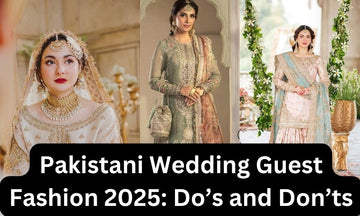There is a cultural revival taking place in Pakistani fashion. When it was easy to define the two, now contemporary and traditional styles mix and match. They are merging the methods of the past with the way our world and our taste evolve today. In the end, there is a movement expanding, in which people re-envision the past instead of only remembering it. The traditions and trends of Pakistan march hand in hand, which results in a style that is accepting, colourful, and strongly reflects who people are.
The Evolution of Traditional Attire in Contemporary Fashion
Reimagining Heritage Fabrics for Today’s Wardrobe
The country’s pride in its fabric heritage can be seen in khaddar, jamawar, lawn, silk and Banarsi. How and when these fabrics are used and worn have started to change.
Recent Pakistani fashion uses these materials to make outfits that appeal to younger people. For example, banarsi fabric, which used to be mainly worn to formal occasions, is now incorporated into jackets, skirts, and even culottes. The fabric Khaddar, which symbolises toughness and freedom, appears in loose jackets and flowy tunics. The progress of fashion isn’t only about how it looks; it’s also about what it means emotionally. It allows someone’s heritage to appear in their daily style without looking outdated.
A lot of fashion brands are now doing this by mixing velvet panels with chiffon or net sleeves to bring out both luxury and lightness.
Shop the latest collections of Pakistani designer dresses UK, featuring luxurious fabrics and intricate detailing, perfect for weddings and celebrations.
Modern Takes on Traditional Embroidery
If fabric is the body of tradition, embroidery is its soul. Zardozi, gota, aar, mirror work and resham have been used for many years to decorate special clothing for weddings and other formal occasions in Pakistan. Now, it’s having a different meaning as the fashion world mixes online and in-store retail.
They are doing mirror work on parts of cropped denim jackets, adding zardozi touches to leather bags, and putting gota designs in minimalist kurta sets. Hoodies and joggers are now seeing a return of ethnic styles, as many are now embroidered and decorated in this way.
It’s not only about looking glossy; it’s about taking back artistic expressiveness. Past, these design techniques were part of very ceremonial events, but now they’re open to everyone in their daily lives.
Explore a stunning collection of Pakistani designer wear, blending traditional artistry with contemporary fashion trends to create unforgettable looks.
The Role of Pakistani Cultural Elements in Modern Fashion
Wedding & Festive Fashion Leading the Fusion Charge
Tradition still plays a big role at Pakistani weddings, but change is starting to appear. Bridal wear is moving away from the old style of wearing lots of heavy embellishments on the lehenga. These days, some brides use a structured blazer or an open-front jacket in place of a dupatta with their lehenga. Experienced designers like Mohsin Naveed Ranjha and Zainab Chottani are making this change, giving us outfits that respect Pakistani traditions but also look modern.
Groom outfits now often include a sherwani with a slim pair of pants, loafers, or even casual sneakers. The purpose is to keep the traditional values alive, but also let people feel comfortable in their garments.
Discover exclusive Afrozeh UK collections, featuring intricate embroidery and rich fabrics perfect for weddings and festive occasions.
Daily Wear Inspired by Heritage
Pakistani culture can be recognised in what people wear on ordinary days, in addition to weddings. Some modern pret outfits have embroidery that is unique to certain regions.
-
Sindhi Mirror Work: Mirror work from Sindh was once common in local outfits, but recently it has started showing up on kurtis, tunics, and co-ord sets. It’s usually carried out by printing it over the sleeves, collars, or side panels, bringing a quick folk element to plain designs.
-
Balochi Stitching: Balochi embroidery is famous for its spherical and colourful patterns. These days, modern designers leave most of the garments plain and just add simple designs to the edge of shirts or the yoke area. Matching neutral bases highlights the understated beauty of the regional art captured by stitching the shoes.
-
Kashmiri Embroidery: The elegant style of Kashmiri thread work using pastel-colored florals is again featured in new lawn and cotton collections. The material is often applied along hems or cuffs or as vertical stripes, which helps to lengthen the overall silhouette for all kinds of outfits.
Because these fashion pieces are based on regional crafts, wearers can proudly wear parts of their cultural heritage that are up-to-date and important.
Experience the elegance of Asim Jofa Pakistan, where tradition meets modernity in stunning designer outfits crafted to perfection.
The Revival of Dupattas and Shawls
Dupattas and shawls, which were once considered traditional or old-fashioned by younger generations, have come back, but now in a way they can call their own. They are being redesigned by designers to stand out in every outfit.
Today, dupatta material could be organza featuring digital looks or painted flowers, and that would be stylish with a co-ord outfit made of solid fabric. Shawls with Kashmiri or Punjabi designs are now popular for dressing up, matched with female suits or modern kurta-pants for a classy and confident style.
There’s a new trend moving in these accessories: trying to understand dignity, grace, and culture, while still keeping their style.
Discover the sophistication of Baroque Pakistan, offering a blend of traditional elegance and contemporary designs for every occasion.
Accessories: Where Art Meets Function
Blending the past and present cultures is largely thanks to accessories. Even though gold jewellery and jhumkas are traditional, their styles and how they are used are evolving.
Minimalist Kundan pendants are often combined with Western chain necklaces these days. The metallic and geometric designs are now a common sight on traditional khussas. Even things like bags are receiving cultural updates—for example, some are made of velvet with delicate embroidery, others are redesigned from potli bags and there are totes influenced by the colours and designs of trucks.
These outfits are worn outside of weddings or special events now. They are designed as everyday clothes which help people express their cultural background.
Make your special day unforgettable with the Crimson Wedding Collection, featuring exquisite designs crafted for timeless elegance.
Sustainable Craftsmanship: A Return to Roots
The way sustainable design is emerging in fusion fashion by using age-old methods stands out as a meaningful change.
More and more, Pakistani companies are getting involved gradually by:
-
Hand-dyeing and natural dyes
-
Handloom weaving
-
Block and screen printing
They are more than being environmentally friendly; they continue as part of our way of living. Efforts to support these industries save dying crafts, helps local artisans make a living and sell consumers unique products that last long. Adan Libas and Khaadi are among the brands supporting the idea, using fashion to help both nature and culture.
The New Generation and Their Fashion Identity
Among the most special elements of this moment is the key role young people have taken in Pakistani fashion. Cultural diversity and foreign study help young designers view heritage in a new way.
They are wearing shalwars with crop tops, making saris with in-built belts and adding regional art on clothes that can be worn by anyone. They share their age-old traditions and techniques through Instagram and TikTok which often makes them go viral and inspires others.
They are improving the old, rather than trying to replace it. For them, tradition influences design by giving a sense of realness, instead of limiting their options.
Explore a stunning range of ethnic Pakistani clothes in the UK, blending traditional charm with modern sophistication for every occasion.
Conclusion
For Pakistan fashion, meeting modernity goes further than dressing up it means starting a cultural discussion. Working on trends from the past and presenting them in new styles, designers and consumers are moulding a new and mixed fashion impact. It shows up in a variety of forms, plays with styles, and means a great deal to every person.
Choosing between tradition and trend is no longer the main idea in fashion. It includes being both, with no hesitation. Pakistan’s fashion industry demonstrates that a look at the past helps guide the industry toward the future.
